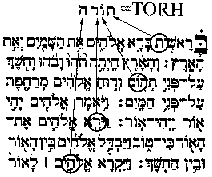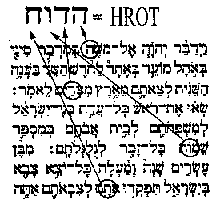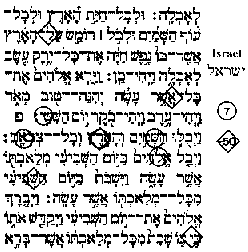![]()
The Triunity Report
ISNET Homepage | MEDIA Homepage | Program Kerja | Koleksi | Anggota
Super Computers
Discover Mathematically Coded Words in the Bible
By
Chuck Missler (From his Book "The Creator Beyond Time and
Space")
|
The conclusions of this Paper have been invalidated with New Research findings. |
A Hidden Torah Secret
The first five books of the Bible (the books of Moses)
are known as the Torah. In Hebrew the work Torah is
represented by the consonants ![]() . Hebrew
is read right from left, so the letters
. Hebrew
is read right from left, so the letters ![]() are equivalent to the English letters "TORH."
are equivalent to the English letters "TORH."
In the Hebrew text of the book of Genesis, if you take the first ("T"), then count 49 letters, the next letter (the 50th) is ("O"); the next 50th is ("R"); and then the next 50th is ("H"). In other words, after the first "T", in 50 letter increments, we find the letters spelling "Torah." (Figure 1)
TORAH in Genesis
(Hebrew is read from right to left)

Interval of 50
In the book of Exodus, we encounter the same result. What a coincidence! (Jewish rabbis insist that "coincidence" is not a kosher word!)
However, it doesn't seem to work with the third book of Moses, Leviticus. But stay tuned.
In the fourth book of the Torah, the book of Numbers, we discover this 49 letter interval works with "HROT," that is, TORH backwards. (See Figure 2)
A similar 49 letter interval also appears in the fifth book the Torah, the book of Deuteronomy. However, in the book of Deuteronomy the interval starts in the fifth verse instead of the first. Why the fifth verse? According to the Talmud the book of Deuteronomy doesn't begin until the fifth verse where it states "On the other side of the Jordan, in the land of Moab, Moses undertook to expound the Torah..."1
Backwards TORAH in Numbers

Interval of -50
In the middle book, the book of Leviticus, it doesn't seem to work either way. But it does work for YHWH, the sacred name of God ("Yahweh" or "Jehovah," translated "LORD" in the King James Version), if you count in seven letter increments. (See Figure 3)
Yahweh in Leviticus

Interval of Seven
It appears that the Torah (TORH) always points toward the Name of God.
Here is the overview:
Genesis Exodus Leviticus Numbers Deuteronomy
TORHTORH
YHWH
HROT
HROT
This may just be another hint that there is much more hidden in the structure of the text itself than we have ever dreamed. Clearly, there is much more to this than first meets the eye of the casual observer.
The Interval of 50
The use of seven with the name of God shouldn't surprise us, with Sabbaths of days, weeks, months, and years, and the many other heptadic2 structures throughout the Bible.3 But why the intervals of 50?
According to mathematician Daniel Michaelson:
"The number 50 has several important meanings in Judaism. Every fiftieth year is a jubilee year; the Torah was given 50 days after the Exodus from Egypt, and there are 50 gates of wisdom."4
Professor Michaelson continues:
"At this point, a skeptical reader would exclaim that the whole system is nothing but a coincidence... 'I'm sure,' this skeptic would continue, 'you would be able to find such words and systems in any book.'"
In his article, Codes in the Torah, professor Michaelson addresses in detail the mathematical probability of these Torah codes and concludes that "the probability of such a coincidence is about one in three million!" (This is one of hundreds of patterns found in the Torah by Rabbi Weismandel during World War II.)5 But we're just getting started. There are numerous patterns that have been discovered by computers since 1982.
The Land and the Sabbath Rest6
In 1982 a real breakthrough occurred when computers were used to examine the Torah. Dr. Eli Rips of the Institute of Mathematics at the Hebrew University in Jerusalem, Dr. Moshe Katz of the Haifa Technion and Doron Viztum of Jerusalem used computers to find meaningful words in the biblical text at equidistant intervals.7 In such a setting the computer is used as a "fast and accurate counting machine."
As an example, the computer was asked to find all
appearances of the word ![]() (Israel) in the first 10,000 letters of Genesis, at equal
intervals ranging from -100 to 100.
(Israel) in the first 10,000 letters of Genesis, at equal
intervals ranging from -100 to 100.
Remarkably, the computer demonstrated that the
word ![]() (Israel) is spelled out
only twice, at intervals of 7 and -50 in Genesis chapter one
(See Figure 4).
(Israel) is spelled out
only twice, at intervals of 7 and -50 in Genesis chapter one
(See Figure 4).
The significance of this finding according to Michaelson is that:
"these are exactly the four verses that constitute the kiddush which we recite over a cup of wine every Friday night to sanctify the Sabbath. This is astounding because seven and 50 are the only numbers related to Shabbat. Seven stands for both the Seventh Day of Creation and the seventh year of shmita when the land rests. After seven shmita cycles the land rests also on the fiftieth year, the jubilee year. Is this merely coincidence? A simple calculation shows that the probability of the word
appearing once at a given interval in the above verses is about 1 in 1200. The chance of two appearances at the intervals of 7 and 50 either backwards or forwards is 1 in 400,000."8
"Israel" in Genesis 1:30-2:3

The name of Israel, found in code, at intervals which speak of resting land on the seventh and fiftieth year! What a coincidence! Why not an interval of eight or 49? Could it be that the One that instituted the Sabbath rest also inspired the very letters of the Torah?
The Return of the Skeptic
The skeptic has tremendous faith in the power of chance. Consequently, it is likely he will argue that chance is sufficient to produce that patterns we have seen. However, it turns out that when a Torah text with only slight variation is examined by computer, statistically significant coded patterns are absent.
The Torah in the "official" Massoretic text (used by the researchers) contains exactly 304,805 letters. The position of the "middle letter" and other strategic points in the text are well known by the scribes.
The Samaritans, who exist to this day, possess a text of the Torah, called the Samaritan Pentateuch, which varies in several hundred points (specific letters) from the Massoretic text. In the seventh century B.C. the ten northern tribes of Israel were exiled. In their place gentiles from various nations were brought into Israel. The Samaritans are thought to be the descendants of those people. Although influenced by Judaism, they were not considered to be part of the Jewish nation. When computers were put to work on the Samaritan Torah, researchers failed to find any significant words in code beyond what was expected to occur statistically by chance.9,10
When the nation of Israel was reborn in 1948, a group of Jews from Yemen returned to Israel with their own Torah scrolls. Although these Jews had been isolated from mainstream Judaism since the destruction of the Temple in 586 B.C., their text varied from the Massoretic text by only nine letters! Yet when it was examined by researchers it too failed to yield the many equidistant "Torah Codes" when the text in question contained even one letter difference!
Finally, to those who would argue that these codes were placed there by rabbis with a lot of time on their hands, we must point out that until the advent of computers the statistical rarity of these design features was not appreciated. With the advent of super computers it has been shown that the frequency of these coded sequences is way beyond the expected random-chance occurrence of such letter sequences.11 Did Moses and the ancient rabbis put these codes in the Torah to impress future generations of computer users?
|
The conclusions of this Paper have been invalidated with New Research findings. |
To order this book "The Creator Beyond Time and Space" go
to:
Koinonia
House Product Catalog
References:
Eastman Mark, M.D., Chuck Missler, "Creation And Time" The Word For Today (1996), p.103-108
Chuck Misslers References and Notes :
-1. Daniel Michaelson, B'OR Ha Torah, Codes in the Torah, Number 6, 1987 English version. To order call Jerusalem, Israel 02-223703 or write "Shamir" B'OR Ha Torah, P.O. box 5749 Jerusalem Israel.
-2. Relating to the number seven
-3. R. McCormack, The Heptadic Structure of Scripture, Marshall Bros. Ltd., London, 1923.
-4. Daniel Michaelson, B'OR Ha Torah, Codes in the Torah, Number 6, 1987, p.10. English version. B'OR Ha Torah, P.O. box 5749 Jerusalem Israel.
-5. Ibid. p. 10. The above is one of hundreds of patterns of found in the Torah by Rabbi Weismandel during World War II.
-6. Adapted from B'OR Ha Torah, Codes in the Torah, Number 6, 1987. p11-39.
-7. ibid, p.11.
-8. Michaelson., p. 14.
-9. For a detailed discussion of the statistics and their implications see he article in B'OR Ha Torah, Codes in the Torah, Number 6, 1987 B'OR Ha Torah, po box 5749 Jerusalem Israel.
-10. There are several versions of the Samaritian Pentateuch so it is difficult to talk about an "accepted version."
-11. In a text as large as the Torah it is, of course, likely that we would find in a certain number of occurrences of any small word at various equal distances in the text. However, when the number of occurences greatly exceeds the number one would expect purely by chance, one must begin to concede that they are not there by chance -but by design.
ISNET Homepage | MEDIA Homepage | Program Kerja | Koleksi | Anggota